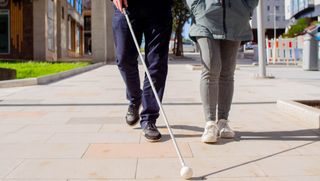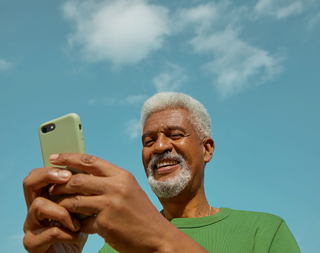White canes for low vision
A guide to white canes and how they may support people with low vision.

Summary
White canes, also known as long or mobility canes are vision aids designed to support people with low vision or blindness with their navigation and mobility. White canes are available in many different styles and types to suit every user’s unique needs, because there is no universal experience of low vision.
When adapting to changes in your vision, the decision to begin using a cane can be both significant and personal. Using a white cane can be an adjustment, but it can be a great tool to assist you navigating unfamiliar environments and promote visibility in crowded spaces. If you feel ready to take this next step on your journey, a low vision Orientation and Mobility specialist can help you find the right cane for you, and support you in learning the best techniques. Below is a short introduction to white canes, how they might be useful for you, and if you feel ready, where to get started.
What is a white cane?
A white cane, also called a long or mobility cane, is a long, straight mobility aid which extends from about your chest to the floor. As the name suggests, it is predominantly white, usually with red ends. The white colour is an international symbol of low vision and blindness, while also providing strong contrast and easy identification. At the end of a white cane is usually a nylon tip, which identifies and detects obstacles on the ground and drop offs, and provides information about different surfaces through auditory and tactile feedback.
What are the types of white cane?
There are two main types of white cane.
- The folding cane is collapsable, making it easy to store when out and about.
- The rigid or straight cane is a solid cane which stays as one piece.
Depending on your needs, a cane can be made of aluminium, graphite or fibreglass.
What kinds of cane tips are available?
Different cane tips are designed for different purposes.
- Pencil tip: a straight, narrow rubber tip which is highly sensitive to changes in the ground, but with a higher risk of catching on surfaces.
- Pear or marshmallow tip: similar sensitivity to the pencil tip, with a wider base to reduce the risk of catching.
- Ball race tip: a round, rotating tip which has a lower chance of becoming stuck, but a reduced sensitivity.
- Rural tip: similar to the ball race tip but fixed, rather than rotating.
- Supaball rolling tip: the largest tip size available, making it heavier but suitable for longer journeys over flat surfaces.
- Bundu Basher: bent like the end of a hockey stick, ideal for grass or bushland terrains.
- Ceramic tip: ceramic material provides the most detailed audio feedback for differentiating between surfaces.
Digital and smart canes
New technology is being developed to enhance traditional cane models all the time. While traditional canes are still widely used, some users may find emerging technologies for canes such as built-in flashlights, GPS, and artificial intelligence (AI) integration useful additions. These technologies are rapidly evolving, so it is best to talk with your Orientation and Mobility provider to determine which technology would be best for you.
Getting started
For support accessing and training with a white cane, visit Guide Dogs Australia’s website to enquire about their Orientation and Mobility services. An Orientation and Mobility specialist can support you in identifying your goals and the types of cane best suited to achieving them, as well as train you to use specific techniques to maximise the effectiveness of your cane.
Remember, a cane is simply a supportive tool to have on hand when you need it – it doesn’t have to be used constantly or else not at all. The decision of when and if you use a cane is always in your hands.
Did you find this article helpful?
Share your thoughts and help us make our resources better for everyone.
Enjoying the content?
Start building your profile to access personalised support, resources, and tools tailored to your eye health journey.

